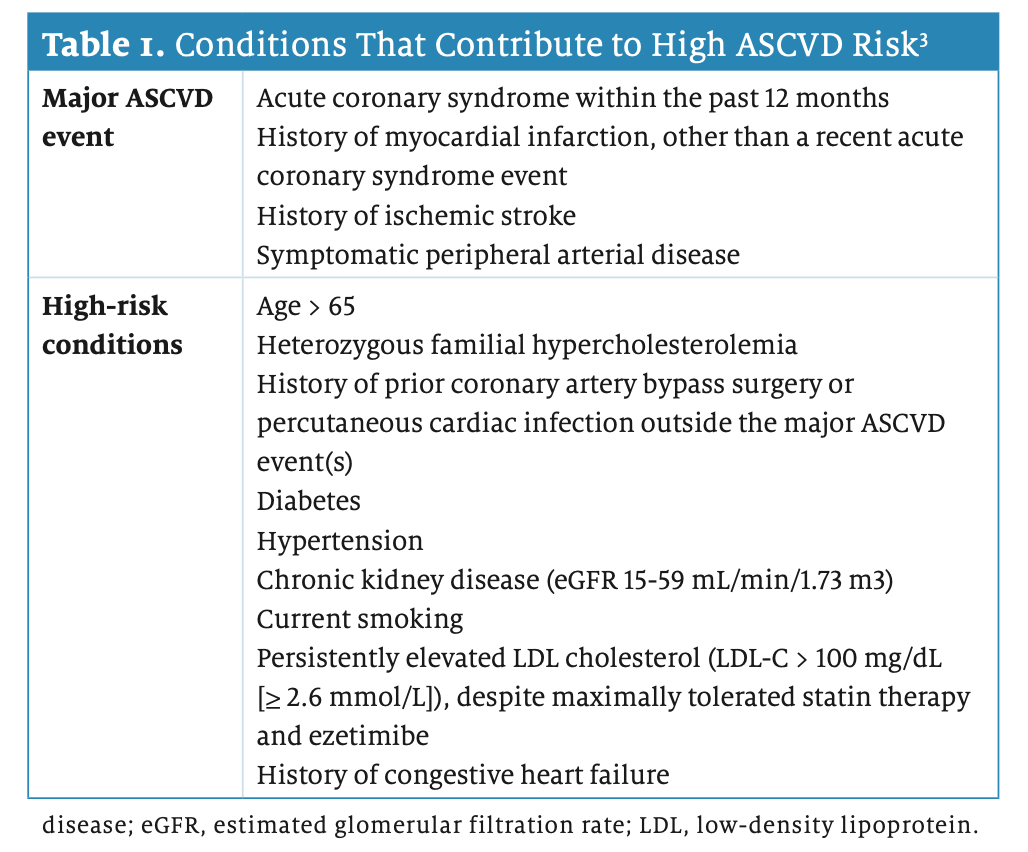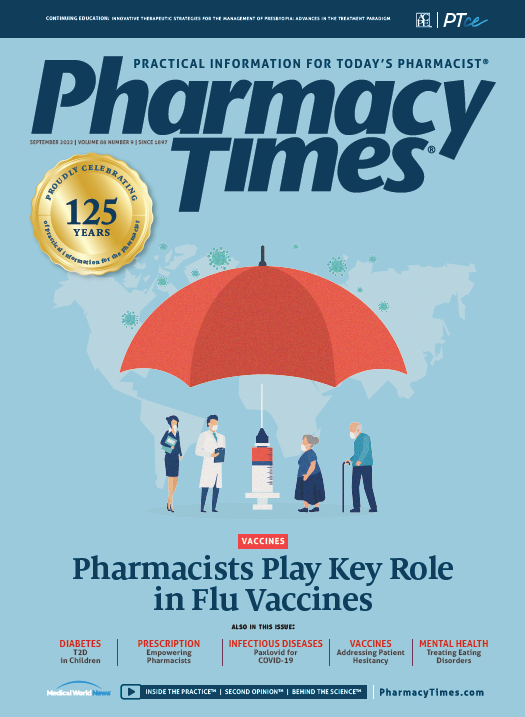Publication
Article
Pharmacy Times
Hypercholesterolemia Counseling Improves Adherence
Author(s):
Pharmacist education also helps prevent adverse reactions, maximizes outcomes for the symptomless disease.
Hypercholesterolemia, a type of hyperlipidemia, is increasing in prevalence in the United States.
According to the CDC, 94 million adults have a total cholesterol (TC) value higher than 200 mg/dL, which is considered hyperlipidemia.1
Although this disease is symptomless, it can drastically increase the risk for developing atherosclerotic cardiovascular disease (ASCVD). Counseling patients about medications for hyperlipidemia can improve adherence, prevent adverse drug reactions, and maximize outcomes.
Risk Classification
Many patients require pharmacologic therapy to improve hypercholesterolemia with consideration of patient comorbidities and other factors. Patients with TC values exceeding 200 mg/dL with no history of ASCVD should receive primary prevention, and those with a history of ASCVD should receive secondary prevention.
For primary prevention, treatment goals are determined by patient factors, such as chronic kidney disease, a family history of premature ASCVD, metabolic syndrome, and others. These patient factors classify patients into low, borderline, intermediate, and high-risk groups. Pharmacists can recommend nonpharmacologic treatment to patients if they are low risk (<5% risk of ASCVD).2 Primary care providers perform a risk assessment on patients at borderline risk (5% to 7.5% risk of ASCVD) to determine the need for drug therapy.2 Patients at higher risk should receive pharmacologic therapy.
Guidelines generally classify patients who need secondary prevention as either non–very high risk or very high risk.3 Clinical signs of very high-risk ASCVD cause variations in patient medication regimens. To qualify as very high risk, patients will have a history of multiple major ASCVD events or 1 major event and multiple high-risk conditions.3 Table 13 describes these conditions.

Nonpharmacologic Treatment
Nonpharmacologic intervention is a backbone of prevention and treatment. Teaching patients about ways to manage lifestyle is vital for best treatment outcomes. Diet, exercise, and other lifestyle recommendations can decrease cholesterol levels. Weight loss related to lifestyle modification provides additional cholesterol benefits.4
Diet
As a first step, pharmacists can recommend tracking food intake. Eating heart-healthy meals decreases the risk of heart disease and stroke by managing cholesterol levels. Fish and poultry are recommended over other meats.5 Fish has lower saturated fats, and oily fish has omega-3 fatty acids, which help reduce heart disease and stroke risk.5 Easy-to-implement recommendations for a heart-healthy diet include increasing fiber and whole grains and lowering dairy fats.
Exercise
Sedentary lifestyles reduce high-density lipoprotein (HDL) levels, also known as good cholesterol.6 Even small amounts of daily exercise have been shown to reduce low-density lipoprotein (LDL) levels, also known as bad” cholesterol, and improve HDL levels.7 Pharmacists can recommend as much physical exercise as possible, but different types of exercise confer different types of benefits. Regular exercise increases HDL cholesterol, displacing LDL. However, aerobic exercise at high intensities reduces LDL directly.7 Common aerobic exercise options, such as biking, brisk walks, and swimming, may also improve blood sugar control, lung function, and weight loss.8
Pharmacologic Treatment
Statins are the most common medications for treating hypercholesterolemia. However, other less common medications, such as ezetimibe or PCSK9 inhibitors, are available as adjunctive therapy or monotherapy.3
Statin Therapy
The dose of statin therapy is classified into 3 classifications: high, moderate, and low intensity (see Table 2).2 Statin intensity determines the lipid-lowering effect. Patients at higher risk for ASCVD use high intensity to lower lipids more than 50%.3

Statin therapy is associated with muscle symptoms, such as injury, myalgia, myopathy, and myositis. Health care providers should educate patients about potential adverse reactions and how to report them to the clinician or pharmacist if they occur. However, recent studies have shown that these adverse effects (AEs) occur in fewer than 1% of patients.9
Another AE of statin therapy is an increased risk of newly diagnosed diabetes mellitus. Most patients who developed diabetes during statin therapy had preexisting risk factors, but the rate of statin-induced diabetes is 0.2% of patients per year.9
PCSK9 Inhibitors
In clinical practice, PCSK9 inhibitors, either alirocumab and evolocumab, is added to low-dose statin therapy or used as monotherapy to patients who are intolerant to statins.10 Compared with other monotherapies, PCSK9 inhibitors reduced lipid levels the most.10 Additionally, they decreased the risk of cardiovascular events like statin therapy.
When considering PCSK9 inhibitors, pharmacists must consider cost-effectiveness.
This therapy is priced at $14,350 per year, according to the Institute for Clinical and Economic Review.10
Although they are very effective, PCSK9 inhibitors will only become a first-line therapy if the price drops.
AEs associated with PCSK9 inhibitors are rare.11 Because PCSK9 inhibitors are injectables, pharmacists should recommend administration of the injection in the top of the outer side of the patient’s upper arm, the stomach or the thigh.12
Ezetimibe
As a less common medication, ezetimibe is an adjunct to statin medications, because PCSK9 inhibitors and statins are more effective.2,3 Common adverse reactions include fever, headache, muscle pain, and sore throat.13
Conclusion

Including patients in the decision-making process is important for best outcomes. Table 3 lists easy-to-read resources that pharmacists can recommend for patients with hypercholesterolemia.
About The Author
Dylan Decandia is a PharmD candidate at the University of Connecticut School of Pharmacy in Storrs.
References
1. High cholesterol facts. CDC. July 12, 2022. Accessed July 14, 2022. https://www.cdc.gov/cholesterol/facts.htm
2. Grundy SM, Stone NJ, Bailey AL, et al. AHA/ACC/AACVPR/AAPA/ABC/ACPM/ ADA/AGS/APhA/ASPC/NLA/PCNA guideline on the management of blood cholesterol: a report of the American College of Cardiology/American Heart Association Task Force on Clinical Practice Guidelines. Circulation. 2019;139(25):e1082-e1143. doi:10.1161/CIR.0000000000000625
3. 2018 guideline on the management of blood cholesterol. American College of Cardiology. Updated June 2019. Accessed July 14, 2022. https://www.acc.org/-/media/Non-Clinical/Files-PDFs-Excel-MS-Word-etc/ Guidelines/2018/Guidelines-Made-Simple-Tool-2018-Cholesterol.
pdf?la=en&hash=608DC2EF8F5381588FA4E51BC436CE077B3C1774
4. Prevention and treatment of high cholesterol (hyperlipidemia). American Heart Association. Updated November 11, 2020. Accessed July 14, 2022. https://www.heart.org/en/health-topics/cholesterol/prevention-and-treatment-of-high-cholesterol-hyperlipidemia
5. Cooking to lower cholesterol. American Heart Association. Updated November 11, 2020. Accessed July 14, 2022. https://www.heart.org/en/health-topics/cholesterol/prevention-and-treatment-of-high-cholesterol-hyperlipidemia/cooking-to-lower-cholesterol
6. 11 foods that lower cholesterol. Harvard Health Publishing. August 13, 2021. Accessed July 14, 2022. https://www.health.harvard.edu/heart-health/11-foods-that-lower-cholesterol
7. Mann S, Beedie C, Jimenez A. Differential effects of aerobic exercise, resistance training and combined exercise modalities on cholesterol and the lipid profile: review, synthesis, and recommendations. Sports Med. 2014;44(2):211-221. doi:10.1007/s40279-013-0110-5
8. Aerobic exercise. Cleveland Clinic. Updated July 16, 2019. Accessed July 14, 2022. https://my.clevelandclinic.org/health/articles/7050-aerobic-exercise
9. Newman CB, Preiss D, Tobert JA, et al. Statin safety and associated
adverse events: a scientific statement from the American Heart Association. Arterioscler Thromb Vasc Biol. 2019;39(2):e38-e81. doi:10.1161/ATV.0000000000000073
10. Chaudhary R, Garg J, Shah N, Sumner A. PCSK9 inhibitors: a new era of lipid lowering therapy. World J Cardiol. 2017;9(2):76-91. doi:10.4330/wjc.v9.i2.76
11. Gürgöze MT, Muller-Hansma AHG, Schreuder MM, Galema-Boers AMH, Boersma E, Roeters van Lennep JE. Adverse events associated with PCSK9 inhibitors: a real-world experience. Clin Pharmacol Ther. 2019;105(2):496- 504. doi:10.1002/cpt.1193
12. Lunven C, Paehler T, Poitiers F, et al. A randomized study of the relative pharmacokinetics, pharmacodynamics, and safety of alirocumab, a fully human monoclonal antibody to PCSK9, after single subcutaneous administration at three different injection sites in healthy subjects. Cardiovasc Ther. 2014;32(6):297-301. doi:10.1111/1755-5922.12093
13. Brar KS. Ezetimibe (Zetia). Med J Armed Forces India. 2004;60(4):388-389. doi:10.1016/S0377-1237(04)80019-4






